Nature Diary
Rocks
History
Gallery
Links
Home Page
 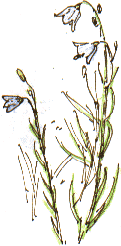 ROACH HILLS is a rough area of trees, scrub and rabbit-nibbled turf on the scarp of the Magnesian Limestone south east of Garforth, overlooking the former mining village of Kippax, with a panorama of Coal Measures countryside beyond. From the holes and heaps it is evident that limestone was once quarried here.
ROACH HILLS is a rough area of trees, scrub and rabbit-nibbled turf on the scarp of the Magnesian Limestone south east of Garforth, overlooking the former mining village of Kippax, with a panorama of Coal Measures countryside beyond. From the holes and heaps it is evident that limestone was once quarried here.
The site is managed by English Nature to encourage a variety of wild flowers. More scrub clearance will be needed. There is no grazing by livestock and the resident Rabbits are unable to keep all the turf close-cropped.

 A Buzzard flies over, perhaps on the look-out for a rabbit. At first, seeing its long tail, we wonder if it is some other kind of bird of prey, but, when it starts to circle around, it fans out its tail and takes on the familiar buzzard silhouette. I can't remember whether this is the first buzzard I've ever seen in West Yorkshire, but they are an unusual sight at this end of the county.
A Buzzard flies over, perhaps on the look-out for a rabbit. At first, seeing its long tail, we wonder if it is some other kind of bird of prey, but, when it starts to circle around, it fans out its tail and takes on the familiar buzzard silhouette. I can't remember whether this is the first buzzard I've ever seen in West Yorkshire, but they are an unusual sight at this end of the county.
(Since I wrote this, the bird watchers who saw it have suggested that the bird's long tail with its irregular barring mark it as a Honey Buzzard. These birds nest in Europe as far north as Scandinavia and are now on migration to winter quarters in southern Africa. The migration enables them to feed all year on their staple diet of wasps and bees, particularly their larvae. The Honey Buzzard will dig out a nest using its feet or tear off an exposed wasps' nest in flight.)
 We're on a Wakefield Naturalists' Society visit, to look at some of the late summer/autumn flora. Autumn Lady's Tresses, with a single row of small green and white flowers arranged spirally on its stems would be easy to overlook. That's the advantage of going out with a group, there are more pairs of eyes to spot things, and, although no-one in the group would claim to be a botanical expert, there's always someone who is able to put a name to an unfamiliar species.
We're on a Wakefield Naturalists' Society visit, to look at some of the late summer/autumn flora. Autumn Lady's Tresses, with a single row of small green and white flowers arranged spirally on its stems would be easy to overlook. That's the advantage of going out with a group, there are more pairs of eyes to spot things, and, although no-one in the group would claim to be a botanical expert, there's always someone who is able to put a name to an unfamiliar species.
  When I see a low growing flower on the turf, I can't help but say 'Wild Thyme'. My friends immediately put me right, it is, as I should have remembered, Eyebright, a small white flower with yellow centres. It is semi-parasitic on other plants.
When I see a low growing flower on the turf, I can't help but say 'Wild Thyme'. My friends immediately put me right, it is, as I should have remembered, Eyebright, a small white flower with yellow centres. It is semi-parasitic on other plants.
If it hadn't been pointed out to me, I would have missed Fairy Flax, now faded back to wiry stems and a few tiny flowers. It is also known as White or Purging Flax, Linium catharticum
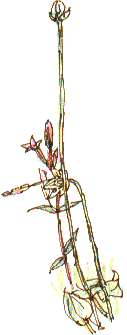 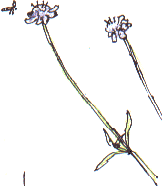 Autumn Gentian was early this year and is now past it's best, as is Grass of Parnassus, the taller plant shown on the left with heart-shaped leaves at its base. Although the five-petalled flowers are faded, the veins on them are still clearly visible. I'm glad to see it again, it's not at all common around here and it reminds me of trips abroad. What a magical name. By the way, one of our Nats members, Pauline, once, back in the hippy era, lived in a cave on the Acropylis in Athens.
Autumn Gentian was early this year and is now past it's best, as is Grass of Parnassus, the taller plant shown on the left with heart-shaped leaves at its base. Although the five-petalled flowers are faded, the veins on them are still clearly visible. I'm glad to see it again, it's not at all common around here and it reminds me of trips abroad. What a magical name. By the way, one of our Nats members, Pauline, once, back in the hippy era, lived in a cave on the Acropylis in Athens.
Harebell, the Scottish Bluebell, grows alongside on the short turf.
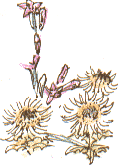 Small Scabious grows on the grassy edge of the path, not far from its larger cousin Field Scabious. Apart from the size difference there are small black whiskers underneath the flowerheads of the Small Scabious, sticking out from the single row of sepals, while the Field Scabious has no black whiskers and a double row of sepals.
Small Scabious grows on the grassy edge of the path, not far from its larger cousin Field Scabious. Apart from the size difference there are small black whiskers underneath the flowerheads of the Small Scabious, sticking out from the single row of sepals, while the Field Scabious has no black whiskers and a double row of sepals.
The seedheads, like symbolic solar discs, of Carline Thistle grow close to the turf.
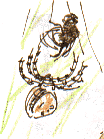  Amongst the grasses we watch a drama unfold. A bumble bee has been caught in an orb web. The spider, which has an abdomen the size of a small pea, keeps the bee at arms length. The bee seems to able to move all but one of its legs, the back leg from which it is suspended, but it tires as the spider keeps gingerly dabbing it with more silk.
Amongst the grasses we watch a drama unfold. A bumble bee has been caught in an orb web. The spider, which has an abdomen the size of a small pea, keeps the bee at arms length. The bee seems to able to move all but one of its legs, the back leg from which it is suspended, but it tires as the spider keeps gingerly dabbing it with more silk.
  We see Common Blue, Holly Blue, Red Admiral and Meadow Brown butterflies.
We see Common Blue, Holly Blue, Red Admiral and Meadow Brown butterflies.
Richard Bell,
wildlife illustrator
E-mail; 'richard@daelnet.co.uk'
Next day
Previous day
Nature Diary
Wild West Yorkshire home page
|

 ROACH HILLS is a rough area of trees, scrub and rabbit-nibbled turf on the scarp of the Magnesian Limestone south east of Garforth, overlooking the former mining village of Kippax, with a panorama of Coal Measures countryside beyond. From the holes and heaps it is evident that limestone was once quarried here.
ROACH HILLS is a rough area of trees, scrub and rabbit-nibbled turf on the scarp of the Magnesian Limestone south east of Garforth, overlooking the former mining village of Kippax, with a panorama of Coal Measures countryside beyond. From the holes and heaps it is evident that limestone was once quarried here.
 A Buzzard flies over, perhaps on the look-out for a rabbit. At first, seeing its long tail, we wonder if it is some other kind of bird of prey, but, when it starts to circle around, it fans out its tail and takes on the familiar buzzard silhouette. I can't remember whether this is the first buzzard I've ever seen in West Yorkshire, but they are an unusual sight at this end of the county.
A Buzzard flies over, perhaps on the look-out for a rabbit. At first, seeing its long tail, we wonder if it is some other kind of bird of prey, but, when it starts to circle around, it fans out its tail and takes on the familiar buzzard silhouette. I can't remember whether this is the first buzzard I've ever seen in West Yorkshire, but they are an unusual sight at this end of the county. We're on a Wakefield Naturalists' Society visit, to look at some of the late summer/autumn flora. Autumn Lady's Tresses, with a single row of small green and white flowers arranged spirally on its stems would be easy to overlook. That's the advantage of going out with a group, there are more pairs of eyes to spot things, and, although no-one in the group would claim to be a botanical expert, there's always someone who is able to put a name to an unfamiliar species.
We're on a Wakefield Naturalists' Society visit, to look at some of the late summer/autumn flora. Autumn Lady's Tresses, with a single row of small green and white flowers arranged spirally on its stems would be easy to overlook. That's the advantage of going out with a group, there are more pairs of eyes to spot things, and, although no-one in the group would claim to be a botanical expert, there's always someone who is able to put a name to an unfamiliar species. When I see a low growing flower on the turf, I can't help but say 'Wild Thyme'. My friends immediately put me right, it is, as I should have remembered, Eyebright, a small white flower with yellow centres. It is semi-parasitic on other plants.
When I see a low growing flower on the turf, I can't help but say 'Wild Thyme'. My friends immediately put me right, it is, as I should have remembered, Eyebright, a small white flower with yellow centres. It is semi-parasitic on other plants.
 Autumn Gentian was early this year and is now past it's best, as is Grass of Parnassus, the taller plant shown on the left with heart-shaped leaves at its base. Although the five-petalled flowers are faded, the veins on them are still clearly visible. I'm glad to see it again, it's not at all common around here and it reminds me of trips abroad. What a magical name. By the way, one of our Nats members, Pauline, once, back in the hippy era, lived in a cave on the Acropylis in Athens.
Autumn Gentian was early this year and is now past it's best, as is Grass of Parnassus, the taller plant shown on the left with heart-shaped leaves at its base. Although the five-petalled flowers are faded, the veins on them are still clearly visible. I'm glad to see it again, it's not at all common around here and it reminds me of trips abroad. What a magical name. By the way, one of our Nats members, Pauline, once, back in the hippy era, lived in a cave on the Acropylis in Athens. Small Scabious grows on the grassy edge of the path, not far from its larger cousin Field Scabious. Apart from the size difference there are small black whiskers underneath the flowerheads of the Small Scabious, sticking out from the single row of sepals, while the Field Scabious has no black whiskers and a double row of sepals.
Small Scabious grows on the grassy edge of the path, not far from its larger cousin Field Scabious. Apart from the size difference there are small black whiskers underneath the flowerheads of the Small Scabious, sticking out from the single row of sepals, while the Field Scabious has no black whiskers and a double row of sepals.
 Amongst the grasses we watch a drama unfold. A bumble bee has been caught in an orb web. The spider, which has an abdomen the size of a small pea, keeps the bee at arms length. The bee seems to able to move all but one of its legs, the back leg from which it is suspended, but it tires as the spider keeps gingerly dabbing it with more silk.
Amongst the grasses we watch a drama unfold. A bumble bee has been caught in an orb web. The spider, which has an abdomen the size of a small pea, keeps the bee at arms length. The bee seems to able to move all but one of its legs, the back leg from which it is suspended, but it tires as the spider keeps gingerly dabbing it with more silk.
 We see Common Blue, Holly Blue, Red Admiral and Meadow Brown butterflies.
We see Common Blue, Holly Blue, Red Admiral and Meadow Brown butterflies.